African violets are the best plants for any indoor garden because, with the appropriate growth circumstances, they can bloom all year. There are almost 16,000 recognized types of these lovely houseplants. Lavender, soft pink, purple-blue and pure white flowers are can be grown, and some varieties feature double-petaled that blooms in a variety of colors.
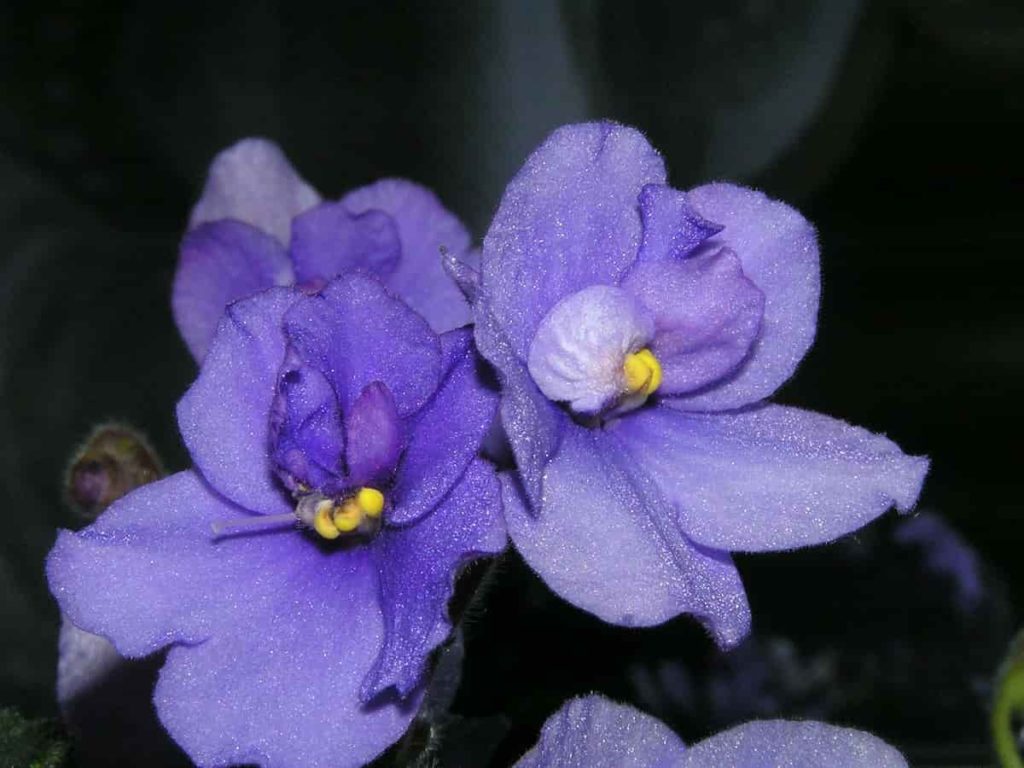
The plants can range in size from 6 inches in diameter to more than 16 inches in diameter. African violets can flourish inside if you follow a few easy principles. With a little practice, you can maintain them blooming almost all year. Let’s check out the detailed guide to growing African Violets from seeds,
How to Grow African Violets from leaves?
From a leaf, you can grow a new plant in water. The most frequent method for growing new African violets is from the leaves. After that, you can soak the cutting in water to sprout it. You’ll need a sterilized cutting instrument, a thin-necked container, and a plastic bag or wrap to grow a new African violet in water. Take a leaf from a healthy African violet that is huge and healthy. Include 2 inches of stem and a 45-degree angle when cutting the leaf off the plant. The angle’s cut side should be at the top of the leaf. Using lukewarm water, fill the bottle halfway.
How to grow African violets from seeds?
Starting African violets from seed is a viable option, though it is less popular than growing the plants using cuttings. Seed starters, a plastic wrap, growth lights, a spray bottle and a medium suited for African violets, such as pasteurized peat moss, are all required to grow African violets from seeds.
In case you miss this: How to Make Flowers Bloom Fast, More, Tips, Ideas and Techniques
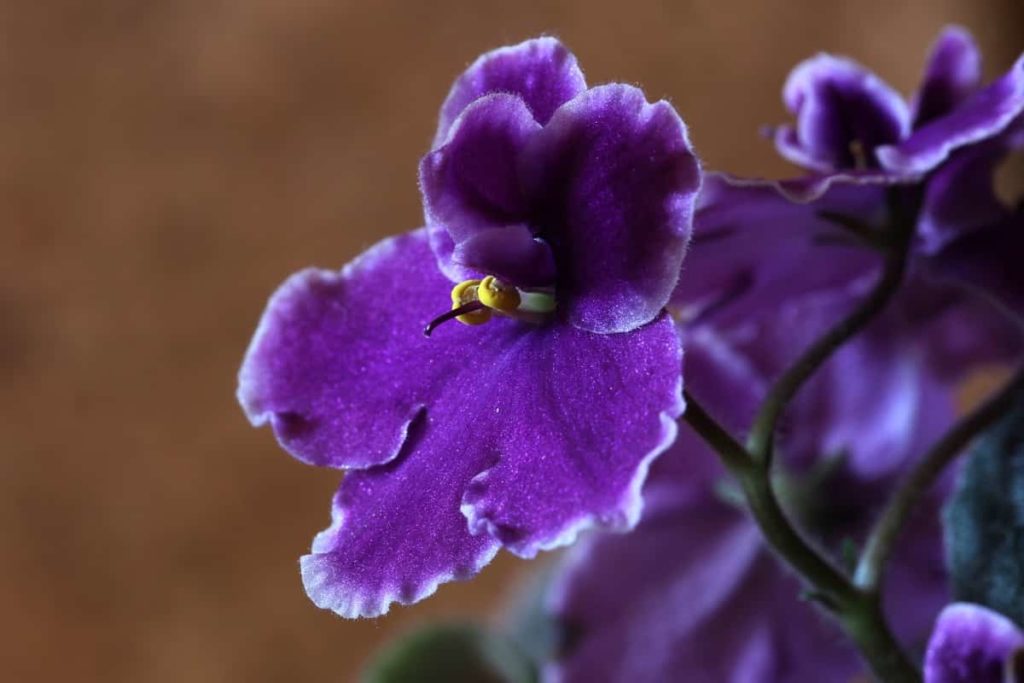
Allow the medium to dry out before watering it again to keep it wet. Fill seed starters halfway with the medium. Using a spray bottle, wet the top of the medium. Several seeds should be strewn across the top of each beginning cell. Plastic wraps the tops of the cells. 10 inches below the grow lights, place the seed starters.
How to grow African violets from direct soil?
Instead of sprouting it in water, you can plant the cutting directly into the soil. For e this, you’ll need a healthy violet leaf and 2 inches of stem, a tiny transparent potting soil, a plastic pot, and a plastic wrap. Fill the container halfway with potting soil. Half-inch into the dirt, press the clipped stem. Wrap a transparent plastic cover around the pot’s top. Place the cutting in a warm area with plenty of filtered sunlight. As the plastic keeps the moisture in, you won’t need to water.
Guide to growing African Violets from seeds
Soil management to grow African violets
African violets can be found in a variety of soils and soil mixes. African violets flourish in a mildly acidic environment with a pH of 6.4 to 6.9. Well-drained, well-aerated soil with a high proportion of humus or organic matter yields the greatest results for gardeners. A mixture of 1 part leaf mould, 1 part peat moss, 1 part sand, and 2 parts loamy topsoil produce satisfactory results in most cases.
Violets grow well in artificial mixtures such as peat-vermiculite and peat-perlite. They will be pretty clean and devoid of the majority of insects and pathogens. A combination of equal parts soil, peat moss, and horticultural perlite can be used. Perlite can be replaced by vermiculite. Artificial mixes are preferred by certain violet producers because their quality is stable, whereas sand and soil might vary. Violets thrive in sterilized potting soil or a commercial African violet soil blend.
Potting and spacing for African violets
African violets require a potting mix that drains fast and should not retain extra moisture. For the greatest results, use a loose, peat, and perlite-based mix. For appropriate root development, many market African violet soil mixtures are excessively rich and heavy. Pots should be one-third to half the diameter of the plant for optimal flowering. For optimum drainage and root aeration, use shallow pots. Once a year transplant your plant in fresh soil and a clean pot.
In case you miss this: Top 10 Flowers to Grow in Pots
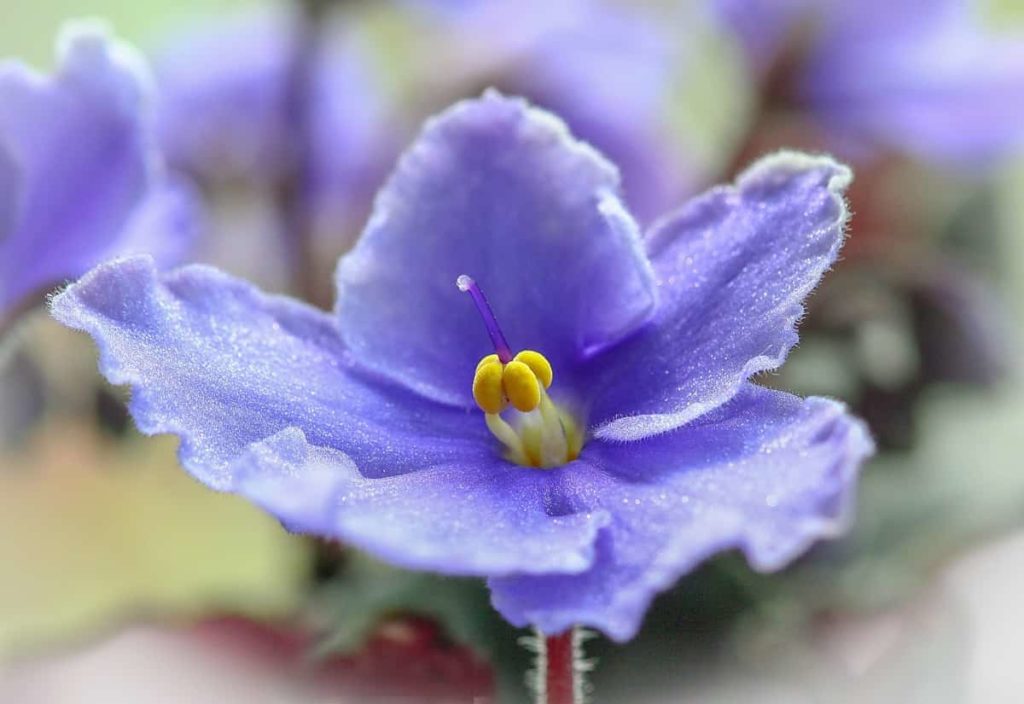
The importance of spacing cannot be overstated. Allow adequate space for your plant to grow without touching its neighbors. The spacing provides for more uniform development and prevents pests and illnesses from spreading readily. Pull off any new plantlets that emerge along the stem to minimize crowding in the container and to maintain the plants symmetrically.
Fertilization required for African violets
African violets, like other plants, benefit from frequent fertilizer applications. Most violet hobbyists like to use liquid fertilizers every four to six weeks, such as 20-20-20. You can also use dry fertilizers, as well as slow-release or encapsulated fertilizers. Before using a dry fertilizer, make sure the soil is wet. Understand and follow the manufacturer’s guidelines regardless of the type of fertilizer you use. Plants that are growing in less-than-ideal circumstances or at non-active periods of development may need less fertilizer.
African violets are extremely sensitive to soluble salt build-up, which can harm plant roots. Many indoor gardeners find that applying one-third to one-half the suggested quantity of fertilizer produces the greatest results; however, using too little fertilizer might cause growth slowdown and/or other deficiency symptoms. It’s also worth noting that too much fertilizer might cause symptoms that resemble deficiencies. The easiest way to figure out what’s wrong is to do a soil test.
Sunlight required for African violets
When African violets are given the proper quantity of light, they thrive, stay healthy, and produce an abundance of flowers. In the winter, the best light comes from windows facing south or west. During the summer, windows with an east or north direction are ideal.
The most prevalent reason for African violets’ inability to blossom is a lack of light. The leaves of violets that are grown in too little light become deeper green and thin, the leaf stalks become very long and feeble, and the plants blossom very infrequently.
In case you miss this: Top 18 Flowers to Grow on the Terrace
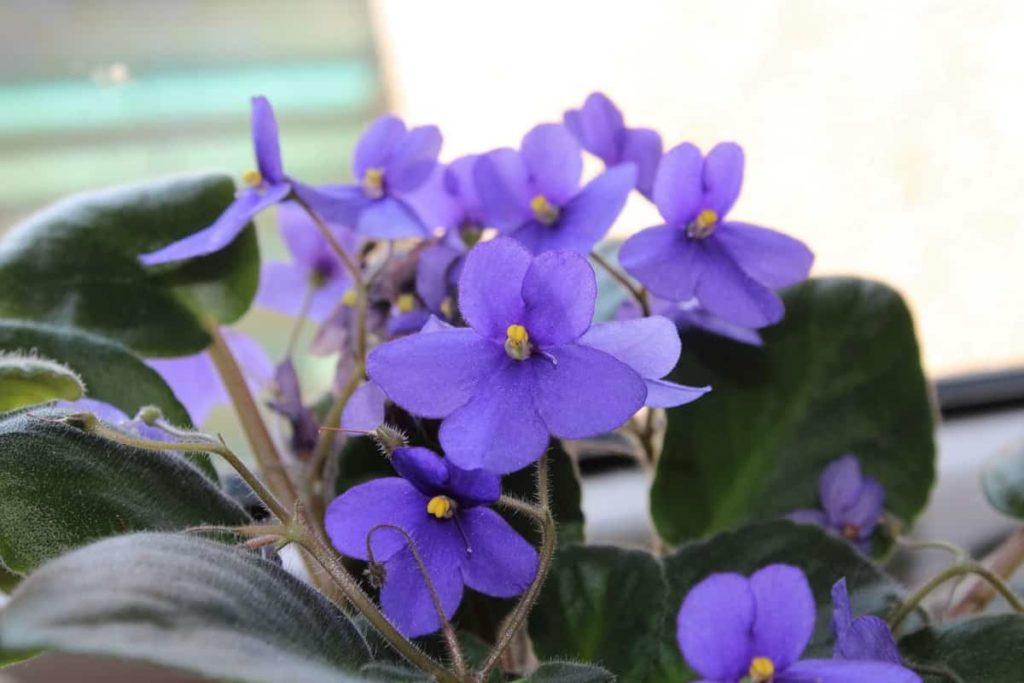
Growing African violets by artificial light
Artificial light may be used to readily cultivate African violets. For 14 to 16 hours a day, the intensity of roughly 600-foot candles is recommended. Lights may be turned on and off automatically using inexpensive timers.
The most common light source is fluorescent lighting, which may be organized in tiers or affixed to shelves for a handy and appealing light source. The tubes should be placed 12 to 15 inches above the plants’ tops. A shelf with two or more 20- to 40-watt tubes may support a large number of plants. Several firms provide light tubes intended exclusively for plant development. The light released includes additional radiant energy that may be used.
Because of the weak light spectrum and high heat they emit, standard incandescent bulbs are not advised as a light source. Special incandescent spotlights of 75 and 150 watts are available for plants. When placed 12 to 18 inches away from the plants, they give useful quantities of light energy.
Ideal temperature and humidity for growing African Violets
The most appealing violets are cultivated at temperatures of 65° to 70°F at night and 70° to 90°F during the day. Plants that are cultivated at temperatures below 60 degrees Fahrenheit will be distorted. Curling, cupping, and brittle leaves are possible. Deformed and discolored flowers are possible. At colder temperatures, the leaf may turn a light green color, especially when cultivated in the right light.
Avoid planting the plants in areas where the temperature is over 90°F or below 60°F for optimal results. Humidity is critical for African violet development. Violets can develop and blossom in the humidity levels seen in most households. Plants that grow under increased humidity are more successful. There are devices on the market that raise the humidity in the home, which is beneficial to both plants and people.
Humidity can be enhanced by placing pots in plastic trays of water and gravel or pebbles when only a few plants are involved. The water level in the tray should be less. Allow the pots to sit on stones or inverted shallow pot saucers rather than in water.
In case you miss this: Top 15 Flowers to Grow in the Backyard
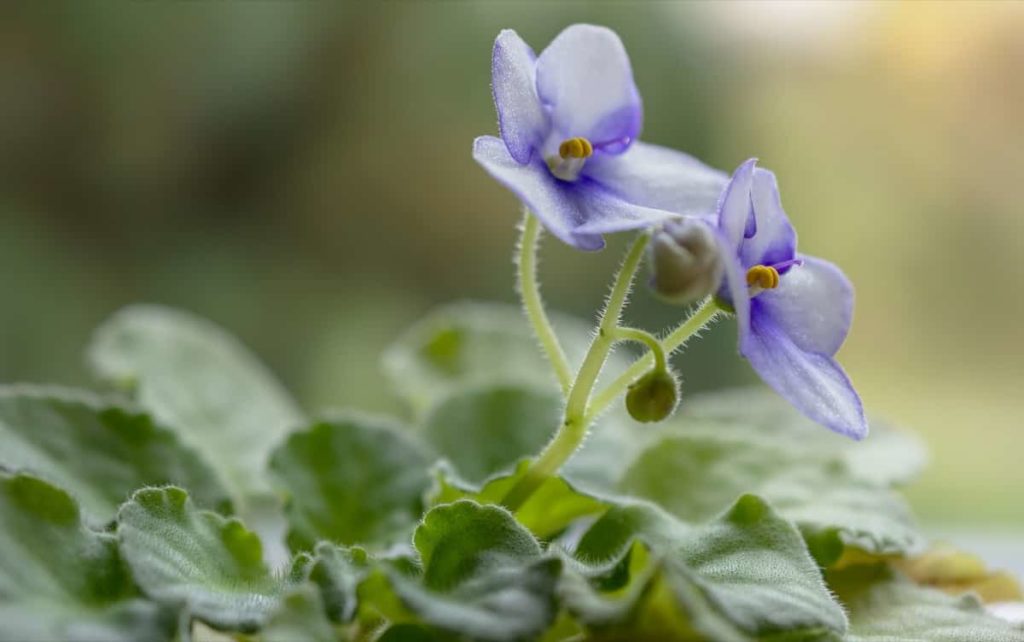
African violets problems and their solutions
Leaves curling
African violets, like many of us, like cuddling. When they feel chilly, they, like humans, constrict and huddle up to save heat. Your African violet leaves aren’t warm enough if they curl under and become brittle. To defend itself, your plant may have developed additional “fur” on its leaves.
If you suspect cold air is the blame, move your African violet from that draughty corridor or chilly great room to a more comfortable location. Your plant will thrive in a room with a constant temperature of 68-70 degrees Fahrenheit. Support your plant with a tiny heat lamp if you have problems maintaining a steady temperature in your house during the winter months.
Leaves turning brown
The luxuriant, deep-green foliage of African violets is well-known. That’s why brown, crispy leaves are a dead giveaway that something isn’t right. This condition in your plant might be caused by a variety of factors like too much fertiliser or water spots.
The leaves of African violets are particularly water-sensitive. Brown spots and sunburn might occur if you get your plant’s leaves moist when watering and then expose them to direct sunlight. Unfortunately, the injured leaves will not recover if this is the case. They’ll have to be taken out.
When African violets are overfertilized, their sensitive root systems can rapidly succumb. Examine the soil, leaves, and rim of your pot for salt accumulation. Flush the soil gently with room-temperature water if you find orange or yellow-ish crystals. To avoid nutrient accumulation underground, we recommend using a moderate, urea-free fertilizer in the future.
Leaves turning yellow
In general, getting African violet leaves wet might create issues. This is because water that is colder or warmer than the ambient temperature of your plant might shock and damage the cells in the leaf. As a result, yellow leaves and bleached patches appear. Unfortunately, the leaf will not recover if this occurs. To avoid this problem in the future, trim the afflicted leaves and water from the bottom.
In case you miss this: Top 20 Flowers To Grow In A Greenhouse

Leaves turning white
White mildew, a common fungal disease that infects indoor plants, is to blame for this. Winter months are good breeding grounds for this powdery bug because of the warm temperatures and shuttered windows. If your plant has been infected, remove any diseased leaves and place them in a location with improved circulation while you keep an eye on them for any further breakouts.
Brown spots on leaves
Chloramines are disinfectants that are often employed in the treatment of drinking water. They’re safe for people in tiny doses. However, if you’re watering your African violet with tap water, you might be causing this leaf issue. If you believe your water includes chloramines, boil it for a few minutes to lessen the concentration, or use store-bought water for gardening.
Frequently asked questions
How often should African violets be watered?
While bottom watering African Violet plants, it’s crucial to remember to topwater at least once a month. In this manner, any excess fertilizer salt is flushed out, and the soil and roots are refreshed from the top as well.
How often should you repot your African violet?
Repotting African violets should be done every 5-6 months or twice a year. Once the plant has reached maturity, just report it in the same size pot with fresh soil.
What kind of soil do African violets need?
African violets flourish in soil that is loose, porous, and drains well. Your home growing conditions such as humidity, heat, and light—should be the first consideration when selecting an ideal potting mix. Choose an organic matter-rich mix if your home is deficient in humidity.
- How to Grow Tomatoes Organically at Home: A Comprehensive Guide
- Organic Gardening on a Budget: Low-Cost Methods and Materials
- Gongura Seed Germination and Planting Methods
- Cabbage Seed Germination and Selection
- Broccoli Seed Germination and Selection
- Asparagus Seed Germination and Variety Selection
- Seasonal Flower Gardening: Best Practices for Spring, Summer, Fall, and Winter
- How to Grow Hibiscus from Flower
- Plantation Ideas for Home Decoration: A Beginners Guide
- Flower Garden Designs and Layouts for Beginners
- Planting and Spacing Techniques in Papaya: A Beginner’s Guide
- Growing Gold: Essential Techniques for Planting Pineapples
- How to Make Kalanchoe Plant Bushy: Home Remedies and Solutions
- 11 Reasons Why Your Gardenia is Not Blooming: Home Remedies and Solutions
- Eco Elegance: The Guide to Designing a Drought-Tolerant Landscape
- Gardening on a Slope: Strategies for Hillside Landscaping
- Nourish and Flourish: Top Organic Mulches for Thriving House Plants
- Everything You Want to Know about Indian Mogra Flower: Discover Uses and Growing
- Green Thumb Success: Expert Tips for Cultivating Greenhouse Pumpkins All Year Round
- Maximize Growth & Flavor: The Ultimate Guide to Companion Planting in Herb Gardens
- How to Control Rhododendron Problems Naturally: Home Remedies and Organic Ways to Fix Them
- Natural Magic: The Remarkable Benefits of Cinnamon for Plants
- Best Steps to Revive Dying Tulip with Natural and Organic Treatment
- 10 Reasons Why Your Angel Trumpet is Not Blooming: Remedies and Treatment
- How to Fix Periwinkle Leaf and Flower-Related Problems: Natural Remedies and Solutions
- How to Fix Zinnias Leaf and Flower Problems: Discover Natural and Home Remedies
- Organic Steps to Induce Lemon Tree Flowers: A Comprehensive Guide
- Bloom Booster: Crafting the Perfect Homemade Bougainvillea Fertilizer
- Optimizing Growth: A Guide to Applying NPK Fertilizer for Potted Plants
- 10 Best Homemade Fertilizers for Rubber Plant: DIY Recipes and Application Method
- How to Boost Female Pumpkin Flowers: Effective Steps for More Flowers and High Yields
- Transform Your Indoor Garden: Top Benefits of Pink Salt for Houseplants
- 10 Best Homemade Fertilizers for Peacock Plants (Calathea): Easy DIY Guide
- Unlock Blooms: 9 Reasons Why Your Potted Chrysanthemum is Not Blooming
- 8 Reasons Why Your Potted Hibiscus is Not Blooming: Fix it with Simple Solutions
- Unlock Blooms: 9 Key Reasons Your Potted Frangipani Won’t Flower